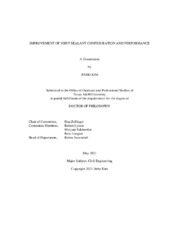| dc.description.abstract | The jointing of concrete pavement is intended to provide free movement within the concrete slab. Joint sealing material, called a joint sealant, has evolved in recent decades to prevent or reduce the amount of water from rainfall events infiltrating a pavement structure. As this evolution has progressed, joint sealant practices have changed. However, current practices and their respective performances have yet to be fully documented. Therefore, it is necessary to establish a standardized approach to joint sealant evaluation, as well as investigate and assess joint sealant practices in Portland cement concrete design.
Current joint sealants are designed without consideration of the strength and shape of the bond between the concrete and sealant and its effect on stress concentration. This often results in adhesive failure within 1.5 years, much earlier than the expected service life of the joint sealant (20 years). Bond strength and stress on the interface between the sealant and joint reservoir face play important roles in adhesive failure. Therefore, in the present research, experimental bond tests and a finite element method (FEM) analysis are conducted to examine the nature of the bond at the sealant/joint reservoir interface. In addition, the stress distribution along the interface is also investigated by analyzing the geometric shape factor (SF), degree of curvature (DoC), and joint preparation conditions.
For this study, data is gathered through a literature review, the survey of Departments of Transportation (DOTs), and subsequent discussions with selected agencies to determine case documentation practices. In addition, re-evaluation of the SF was conducted, and a new design factor, DoC, is introduced and explored through the FEM and experimental analysis. With these factors, the reduction of bond strength and increase in stress at the interface may be limited, reducing the potential for early adhesive failure. This study examines the effects of moisture content on bond strength, the main cause of joint sealant failure. Sealant use in various climatic regions throughout the United States is examined, and DOTs are surveyed with regards to how they handled moisture.
As a result of this investigation, it becomes clear that some advances in the composition, design, and preparation of sealants, especially in terms of the design of and inspection methods for narrow joints, appear to conflict with established recommendations. It also appears that institutions lack the necessary tools and control protocols to facilitate the proper inspection of cleaning and joint preparation work. The effects of poor joint preparation (i.e., dirt and moisture) on joint strength and the shape of the joint sealant (i.e., SF and DoC) should be considered when designing and installing sealants. This research evaluates the effects of surface moisture on the tensile bond strength between a joint sealant and reservoir. The causes of degradation in adhesion strength are evaluated by measuring the sealant wetting angle. Finally, it is determined that the best choice of sealant may depend on climate. Those not currently preferred in wet-freeze regions may be used if accompanied by proper pretreatment and moisture control, contributing to the stable lifespan of joint sealants and concrete pavement alike. | en |


